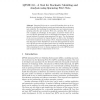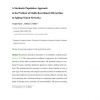545 search results - page 4 / 109 » Modeling the tele-immersive systems using stochastic activit... |
BIRTHDAY
2010
Springer
13 years 4 months ago
2010
Springer
Abstract Queueing Petri nets are a powerful formalism that can be exploited for modeling distributed systems and analyzing their performance and scalability. By combining the model...
GECCO
2007
Springer
13 years 11 months ago
2007
Springer
A primary goal of evolutionary robotics is to create systems that are as robust and adaptive as the human body. Moving toward this goal often involves training control systems tha...
BC
2006
13 years 7 months ago
2006
Recruitment learning in hierarchies is an inherently unstable process (Valiant, 1994). This paper presents conditions on parameters for a feedforward network to ensure stable recru...
RP
2009
Springer
14 years 2 months ago
2009
Springer
Abstract. We compare several languages for specifying Markovian population models such as queuing networks and chemical reaction networks. These languages —matrix descriptions, s...
ACCV
2006
Springer
13 years 11 months ago
2006
Springer
Stochastic grammar has been used in many video analysis and event recognition applications as an efficient model to represent large-scale video activity. However, in previous works...


